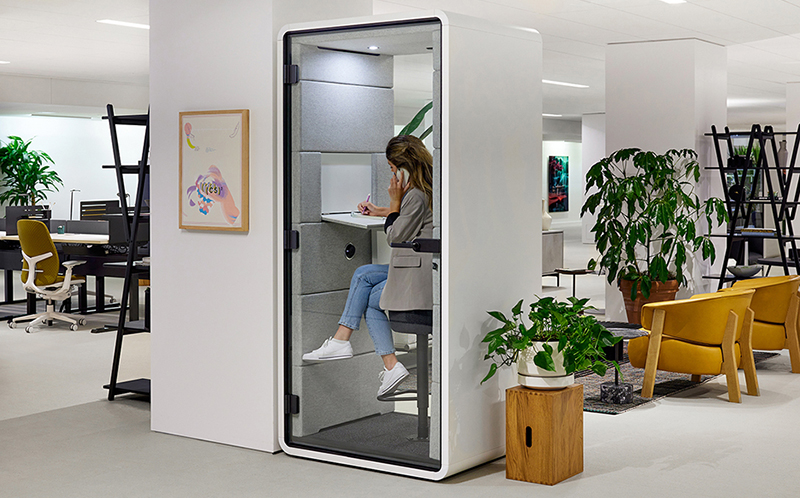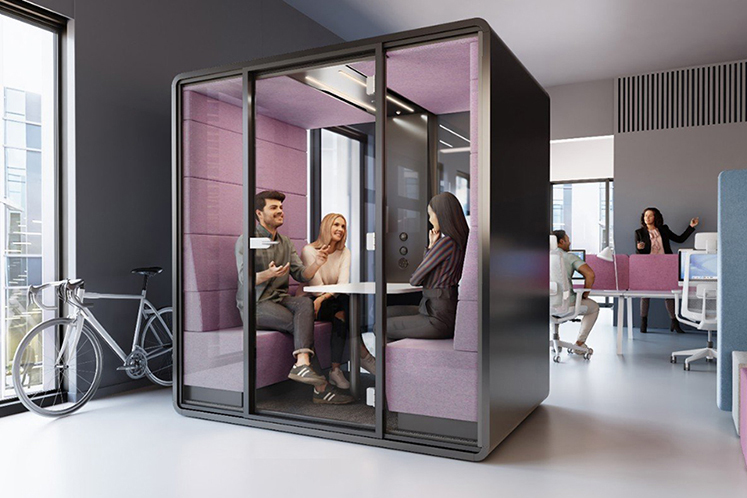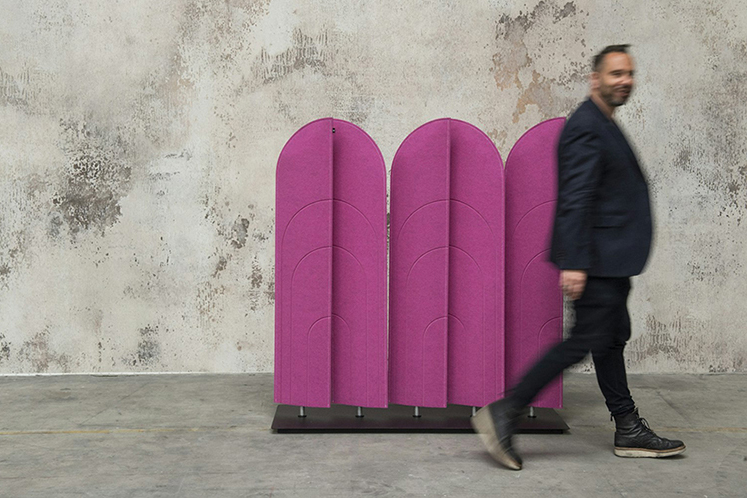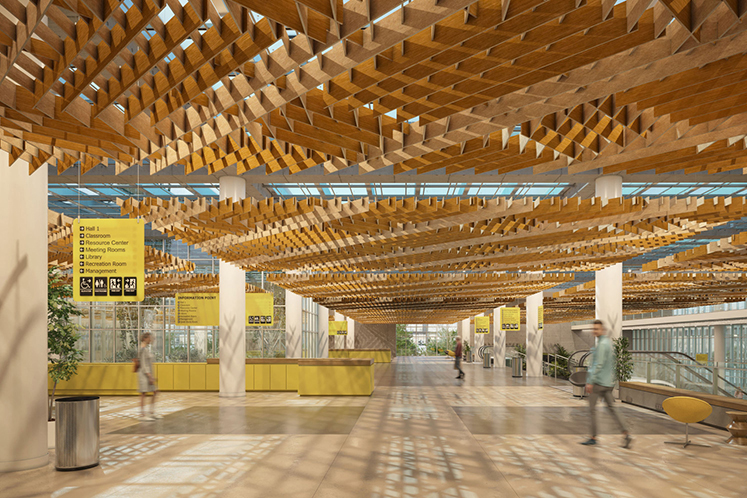The Impact of Acoustics on People and Spaces

Distractions are everywhere in today’s world.
And while 70% of people say they’re distracted by workplace noise, it’s not just in the workplace. It’s everywhere people meet, work, connect, wait, learn, and heal. We’re constantly being bombarded with stimulus from digital devices, elevators, monitors, building systems, and yes, each other.
Good acoustic design plays a crucial role in the quality of people’s experiences in the built environment. Whether you’re specifying for a workplace, learning space, or hospitality space, good acoustic design makes these spaces work and feel better.
Acoustics in the Workplace
You know that feeling. When you’re interrupted and then it takes so much time to get back to where you were and what you were doing? And sometimes you never quite get there? That happens throughout any given day in noisy, distraction-prone workspaces. For employees, distractions are frustrating and demotivating. For organizations, they’re costly.
Open office layouts bring special challenges in noise reduction
Focused, head-down work necessitates a distraction-free environment. But studies say the average time spent on a task before we get distracted is about 11 minutes. People who work with unwanted noise and interruptions in the workplace are less motivated, more stressed, and generally frustrated, say findings by Haworth. Today’s open office layouts must provide a balance of quiet options to allow for uninterrupted work and private conversations—live, phone, or video. Privacy pods, like these Hushoffice acoustic pods by Haworth, can be located practically anywhere in an open environment, giving people control over their work environment through freestanding phone pods, work pods, meeting pods, and office pods.

Excess noise has a direct impact on employee wellbeing
It takes mental energy to filter out irrelevant sounds. And it’s stressful to work in spaces that aren’t designed to support your best work. Studies that measure employee satisfaction show that unwelcome noise is a key source of dissatisfaction in the workplace. In fact, some 70% of people say they’re distracted by noise in their work environment, according to the Udemy in Depth Workplace Distraction Report, 2018.
Acoustics and Learning
Studies repeatedly show that classrooms with well-planned acoustics are better learning environments. Speech development, language, and cognitive abilities are all influenced in different ways by the acoustic quality of a learning space, say studies cited in research by the journal Building and Environment.
Students participate more
In classrooms with optimal acoustics, students feel more comfortable speaking up and participating in discussions. Because students can hear and understand their peers and the teacher clearly, they’re more likely to actively engage in learning activities and contribute to class discussions.
Adapting for different learning styles
Well planned acoustical design accommodates different learners, learning styles, and pedagogy. It’s important for some students to have access to quiet study areas, while others thrive in more collaborative environments. Small-group work requires a separate area without visual or auditory distraction. Effective noise control solutions help create a quiet space and keep small group work from spilling out into the classroom. Designers can meet these kinds of challenges by specifying flexible acoustic solutions like these freestanding acoustical panels from BuzziBlinds.

These privacy partitions can move and morph in response to different learning needs.
Accommodating sensory sensitivity
In some cases, noise can be all the difference in learning, especially for students with sensory processing challenges who are extremely sensitive to noise or auditory stimuli. A high-quality acoustical environment is necessary and regulating for these learners and a part of inclusive design practices.
Acoustics in hospitality environments
Restaurants have become so loud that critics now rate noise levels with as much significance as food quality. And there are apps that help users find restaurants that allow for social and professional conversations around the table, without yelling. For places where people gather—lobbies, cafes, event spaces, and more—the guest experience is everything. These busy, multipurpose, spaces require great attention to noise control to balance the needs of privacy and openness, quiet and bustle, for both guests and staff.
Bad acoustics and good cuisine don’t mix
Even the best meal can leave a bad taste in your mouth—and restaurants are inherently busy places. In his report, Noise and its impact on the perception of food and drink, from the University of Oxford, Charles Spencer found that “both background noise and loud music can impair our ability to taste food and drink. And more remarkably, that noise selectively impairs our ability to detect tastes, such as sweet and sour while leaving other tastes and flavors relatively unaffected.” Great designs for these spaces balance the necessary hard surfaces with soft furnishings and rugs and incorporate products like Filzfelt’s artful acoustical wall hangings, which provide excellent sound dampening and filtered visual privacy at the same time.
Prioritizing guest comfort
Walking into a hotel lobby should feel like a welcome relief from the world outside. Guest and waiting spaces are the first impression for guests and set the tone for their experience. Yet these are particularly challenging acoustical environments full of noise from people, elevators, phones, kitchens, carts, music, and more. Environmental acoustic treatments like modular acoustic ceiling tiles from Arktura help absorb unwanted sound in large public spaces, and they add interest, color, and texture at the same time.
Balancing privacy and openness
Fostering social interaction is important, but it’s also important to provide areas where guests can have private or small-group conversations or conduct phone calls or video calls without being overheard. Strategic placement of seating areas and the use of acoustic partitions helps strike a balance between openness and privacy in lobby spaces. In venues that configure and reconfigure—for events, receptions, and gatherings—flexible, modular, and movable acoustic solutions provide privacy solutions that can adapt to different uses.
Can you hear me now?
We must be able to hear each other talk. Hotel lobbies are social hubs where guests gather to relax, socialize, and conduct business meetings, often with competing acoustical interests and needs. These can be accommodated through good design. Effective acoustic planning reduces background noise, allowing people to have comfortable conversations at a normal volume.
Building brand identity
Whether it’s a bustling urban hotel, cafe, or restaurant, the acoustic environment should reflect the ambiance and atmosphere that the brand aims to convey. Acoustic solutions providers like Carnegie Fabrics have developed an expansive offering of beautiful acoustic solutions in 350 patterns, colors, and textures for walls, ceilings, baffles, and room dividers. That kind of range means there’s practically no limit to what you can do.
Healthcare Environments
Today’s healthcare environments are loud. And even top-ranked hospitals struggle to maintain a sense of calm in these busy spaces. Studies on acoustics in healthcare environments showed that average sound levels at iconic Johns Hopkins Hospital, for example, average around 45-50 decibels—20+ decibels louder than recommendations by the World Health Organization. Peak levels can exceed 85 decibels in some hospitals, making it difficult for patient-care teams to communicate with each other without resorting to raising their voices. And that further exacerbates the problem. This is good for no one. Not staff, not patients, not their families.
Patient comfort and healing
Healthcare facilities are inherently stressful environments for patients and their loved ones. Excessive noise levels from equipment, monitors, transports, conversations, and other sources can exacerbate this stress, affecting patient comfort and healing. Acoustical ceiling products are a must for controlling overall environment noise. Arktura’s SoftGrid family of modular acoustical ceiling tiles bring beautiful architectural design impact and create a more calming, supportive atmosphere conducive to healing.

Staff communication
Effective communication between healthcare providers and patients is critical for delivering high-quality care. Optimal acoustics in consultation rooms, treatment areas, and patient rooms ensure that patients understand instructions, diagnoses, and treatment plans and reduce the risk of misunderstandings.
Privacy
And then there’s the matter of privacy. Healthcare environments are required by law to maintain patient confidentiality, and this includes sensitive discussions between patients and staff. Sound insulation measures in exam and patient rooms, such as soundproofing walls and doors, help maintain auditory privacy, allowing patients to discuss personal information without fear of being overheard.
Acoustics aren’t merely about reducing noise. By integrating products designed to manage acoustical distraction, businesses, learning environments, hospitality organizations, and healing spaces can create environments that foster more productivity, look great, foster the brand, and promote a healthier well-being among those who live, work, and gather in the space.
Contact WB Wood for help with integrating an acoustics strategy into your space.
